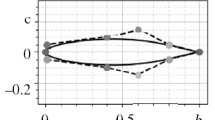Abstract
A design optimization technique is presented which couples a computationally efficient Navier-Stokes code with a numerical optimization algorithm. The design method improves the aerodynamic performance of an airfoil subject to specified design objectives and constraints. Recent advances in computers and compputational fluid dynamics have permitted the use of the Navier-Stokes equations in the design procedure to include the nonlinear, rotational, viscous physics of transonic flows. Using numerical optimization guarantees that a better design will be produced even with strict design constraints. The method is demonstrated with several examples at transonic flow conditions.
Similar content being viewed by others
References
Volpe, G., andMelnik, R. E.,The Design of Transonic Airfoils by a Well-Posed Inverse Method, International Conference on Inverse Design Concepts in Engineering Sciences, Austin, Texas, 1984.
Giles, M. B., andDrela, M.,Two-Dimensional Transonic Aerodynamics Design Method, AIAA Journal, Vol. 25, pp. 1199–1205, 1987.
Vanderplaats, G. N.,Efficient Algorithm for Numerical Airfoil Optimization, Journal of Aircraft, Vol., 16, pp. 842–847, 1979.
Mani, K. K.,Design Using Euler Equations, AIAA Paper 84-2166, 1984.
Chen, M. S., andChow, C. Y.,Numerical Optimization Design of Transonic Airfoils, Numerical Methods in Laminar and Turbulent Flow, Edited by C. Taylor, P. Gresho, R. L. Sani, and J. Haüser, Pineridge Press, Swansea, England, Vol. 6, Part 1, pp. 905–915, 1989.
Lee, K. D., andEyi, S.,Aerodynamic Design via Optimization, Proceedings of the 17th ICAS Congress, pp. 1808–1818, 1990.
Lee, K. D., andEyi, S.,Transonic Airfoil Design by Constrained Optimization, Proceedings of the AIAA 9th Applied Aerodynamics Conference, Baltimore, Maryland, Vol. 2, pp. 677–687, 1991.
Hirose, N., Takanashi, S., andKawai, N.,Transonic Airfoil Design Procedure Utilizing a Navier-Stokes Analysis Code, AIAA Journal, Vol. 25, pp. 353–359, 1987.
Malone, J. B., Narramore, J. C. andSankar, L. N.,Airfoil Design Method Using the Navier-Stokes Equations, Journal of Aircraft, Vol. 28, pp. 216–224, 1991.
Birckelbaw, L.,Inverse Airfoil Design Using the Navier-Stokes Equation, Proceedings of the AIAA 7th Applied Aerodynamics Conference, Seattle, Washington, pp. 346–353, 1989.
Martinelli, L., Jameson, A., andGrasso, F.,A Multigrid Method for the Navier-Stokes Equations, AIAA Paper 86-0208, 1986.
Vanderplaats, G. N.,Numerical Optimization Techniques for Engineering Design, McGraw-Hill Book Company, New York, New York, 1984.
Vanderplaats, G. N., andHansen, S. R.,Dot Users Manual, VMA Engineering, Goleta, Georgia, 1989.
Hicks, R. M., andHenne, P. A.,Wing Design by Numerical Optimization, Journal of Aircraft, Vol. 15, pp. 407–412, 1978.
Ramamoorthy, P., andPadmavathi, K.,Airfoil Design by Optimization, Journal of Aircraft, vol. 14, pp. 219–221, 1977.
Author information
Authors and Affiliations
Additional information
Communicated by D. G. Hull
Rights and permissions
About this article
Cite this article
Eyi, S., Hager, J.O. & Lee, K.D. Airfoil design optimization using the Navier-Stokes equations. J Optim Theory Appl 83, 447–461 (1994). https://doi.org/10.1007/BF02207637
Issue Date:
DOI: https://doi.org/10.1007/BF02207637




